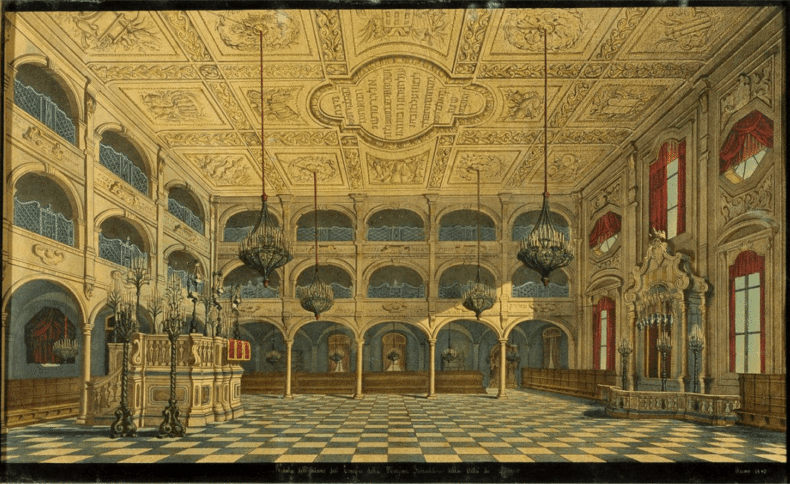The architecture of Italian Jewish life, from synagogues to cemeteries

The Bet HaKnesset, the house of assembly, and the Bet Chaim, the house of life. The synagogue and the cemetery. They are profoundly different and distant places, which apparently share only being a fundamental part of the cycle of Jewish life. Yet, on a closer look, the interweaving of these symbolic spaces tells the complexity of Jewish history over the centuries, as highlighted by the new exhibition of the National Museum of Italian Judaism and the Shoah – MEIS, “Case di vita. Sinagoghe e cimiteri in Italia” (Houses of life – Synagogues and cemeteries in Italy).
Curated by Andrea Morpurgo and the director of Meis Amedeo Spagnoletto, the exhibition – which opened last week and can be visited until 17 September – conveys the religious, social, and cultural significance of both Bet HaKnesset and Bet Chaim. Covering over two centuries of history, the exposition offers projects, designs, documents and objects, architectural features, rituals and social features of both synagogues and Jewish cemeteries in Italy.
“On show is an innovative, original, and in-depth analysis of the synagogue and the Jewish cemetery, two symbolic spaces that, throughout the itinerary, are told from an architectural as well as a ritual and social point of view”, remarked the President of MEIS Dario Disegni at the opening ceremony.
All mayor rituals and lifecycle events of a Jew, from birth to death, take place in synagogues and Jewish cemeteries, but the exhibition is not only a journey into a Jewish life. “It is also an opportunity to discover unexpected details of Italian cities: if in the era of the ghettos the synagogues had to be hidden from the outside world, acting as anonymous ‘caskets’ of extraordinary and precious objects used inside their halls, after the Jewish Emancipation and the Unification of Italy, the Jews wanted to actively participate in urban life and influence the urban land¬scape as well, building monumental temples”.
“Once again, we are back with a theme which is very dear to our museum: the notion of house and home” – explains Amedeo Spagnoletto, Director and curator. “Synagogues are not only or prayers, in fact they are community houses. The title of the exhibition also enshrines the name of cemeteries in the Jewish world, Battè Chaim, which is to say, Houses of Life. Although they are not the same and differ, these two spaces, synagogues, and cemeteries, have harboured the lives, the stories, histories, and identities from thousands of years. Unlike private dwellings, they were spaces where self-representation shifted from a single person’s to the community’s and hence, according to the Jewish tradition, live for ever”.
The hall retraces a path that bears witness to the most complex and the happiest moment of the presence of Jews in Italy, seen through the eyes of history of architecture. Curator Andrea Morpurgo adds: “When dealing with Jewish architecture – and specifically synagogues and cemeteries – we are dealing with identity spaces, able to recreate a fascinating story where memories and stories interface, part and parcel of the history of our country”.
The exhibition has been awarded the prestigious President of the Republic’s Medal and is also supported by the Ministry of Culture, one of the founding partners of MEIS. Participating bodies and authorities include the Region Emilia-Romagna, the City of Ferrara, and the Union of the Italian Jewish Communities. The exhibition is also sponsored by the Intesa Sanpaolo Bank.
Patrons include the Foundation for Jewish Heritage in Italy and the Jewish Community of Ferrara with the support of the Guglielmo De Lévy Foundation, TPER, Hera, CoopAlleanza 3.0, AVIS and the Bottari Lattes Foundation.
Case di vita. Sinagoghe e cimiteri in Italia- Case di vita. Synagogues and Cemeteries in Italy is more than just an exhibition: it is completed by a programme of initiatives involving all the City of Ferrara. Exceptionally, and thanks to the cooperation with the city’s Jewish Community, it will be possible to visit Ferrara’s three synagogues – the German, Italian and the Fano rites, currently not open to the public, and to be found inside the building in via Mazzini that Ser Melli gave the Jews of Ferrara at the end of the 15th century. MEIS will also give you the opportunity to visit the Jewish cemetery of via delle Vigne, locus amoenus with its unique atmosphere, captured by the writer Giorgio Bassani in his timeless novel The Garden of the Finzi-Contini’s.
Above, Moise del Conte, The Old Synagogue Leghorn (Livorno), 1791, Watercolour drawing, Leghorn (Livorno) Jewish Community.
